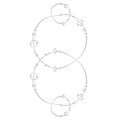Classification of Fatou components
In mathematics, Fatou components are components of the Fatou set. They were named after Pierre Fatou.
Rational case[edit]
If f is a rational function
defined in the extended complex plane, and if it is a nonlinear function (degree > 1)
then for a periodic component of the Fatou set, exactly one of the following holds:
- contains an attracting periodic point
- is parabolic[1]
- is a Siegel disc: a simply connected Fatou component on which f(z) is analytically conjugate to a Euclidean rotation of the unit disc onto itself by an irrational rotation angle.
- is a Herman ring: a double connected Fatou component (an annulus) on which f(z) is analytically conjugate to a Euclidean rotation of a round annulus, again by an irrational rotation angle.
-
Julia set (white) and Fatou set (dark red/green/blue) for with in the complex plane.
-
Julia set with parabolic cycle
-
Julia set with Siegel disc (elliptic case)
-
Julia set with Herman ring
Attracting periodic point[edit]
The components of the map contain the attracting points that are the solutions to . This is because the map is the one to use for finding solutions to the equation by Newton–Raphson formula. The solutions must naturally be attracting fixed points.
-
Dynamic plane consist of Fatou 2 superattracting period 1 basins, each has only one component.
-
Level curves and rays in superattractive case
-
Julia set with superattracting cycles (hyperbolic) in the interior ( perieod 2) and the exterior (period 1)
Herman ring[edit]
The map
and t = 0.6151732... will produce a Herman ring.[2] It is shown by Shishikura that the degree of such map must be at least 3, as in this example.
More than one type of component[edit]
If degree d is greater than 2 then there is more than one critical point and then can be more than one type of component
-
Herman+Parabolic
-
Period 3 and 105
-
attracting and parabolic
-
period 1 and period 1
-
period 4 and 4 (2 attracting basins)
-
two period 2 basins
Transcendental case[edit]
Baker domain[edit]
In case of transcendental functions there is another type of periodic Fatou components, called Baker domain: these are "domains on which the iterates tend to an essential singularity (not possible for polynomials and rational functions)"[3][4] one example of such a function is:[5]
Wandering domain[edit]
Transcendental maps may have wandering domains: these are Fatou components that are not eventually periodic.
See also[edit]
References[edit]
- Lennart Carleson and Theodore W. Gamelin, Complex Dynamics, Springer 1993.
- Alan F. Beardon Iteration of Rational Functions, Springer 1991.
- ^ wikibooks : parabolic Julia sets
- ^ Milnor, John W. (1990), Dynamics in one complex variable, arXiv:math/9201272, Bibcode:1992math......1272M
- ^ An Introduction to Holomorphic Dynamics (with particular focus on transcendental functions)by L. Rempe
- ^ Siegel Discs in Complex Dynamics by Tarakanta Nayak
- ^ A transcendental family with Baker domains by Aimo Hinkkanen, Hartje Kriete and Bernd Krauskopf
- ^ JULIA AND JOHN REVISITED by NICOLAE MIHALACHE






















